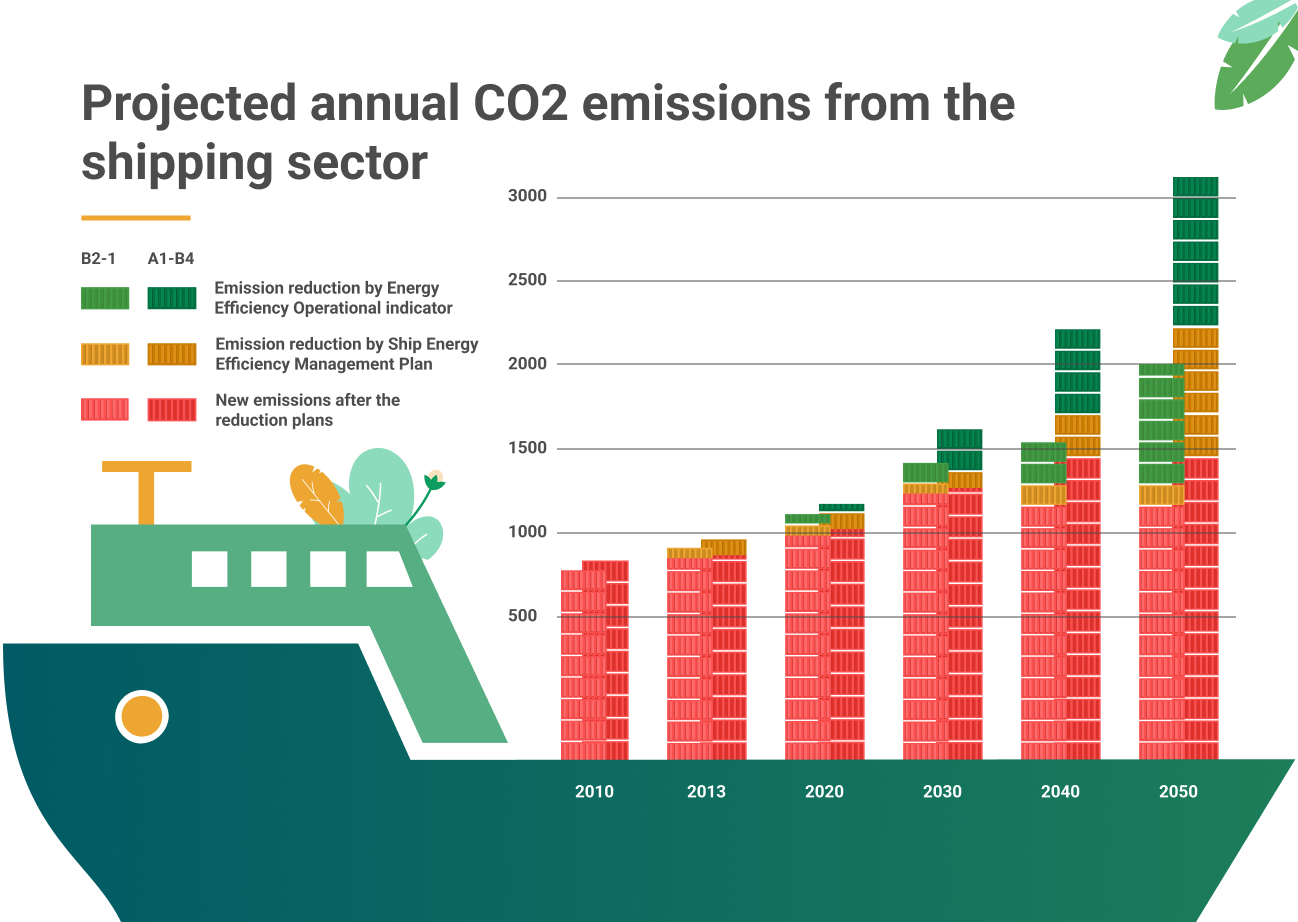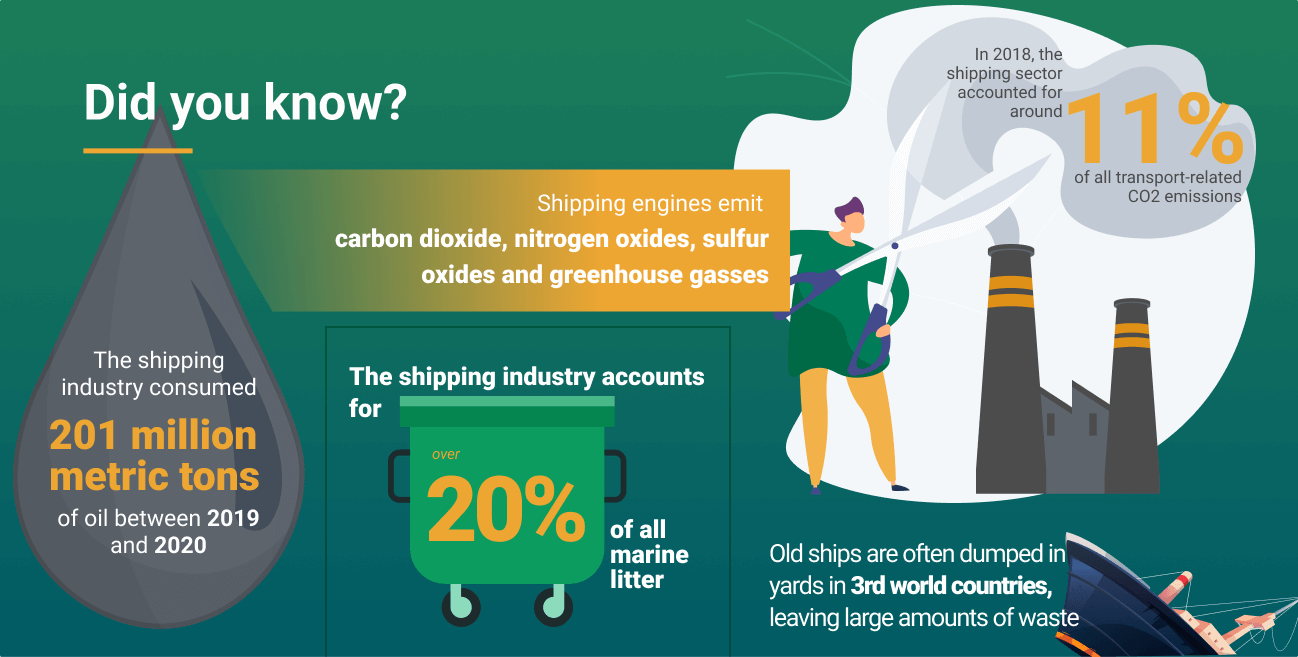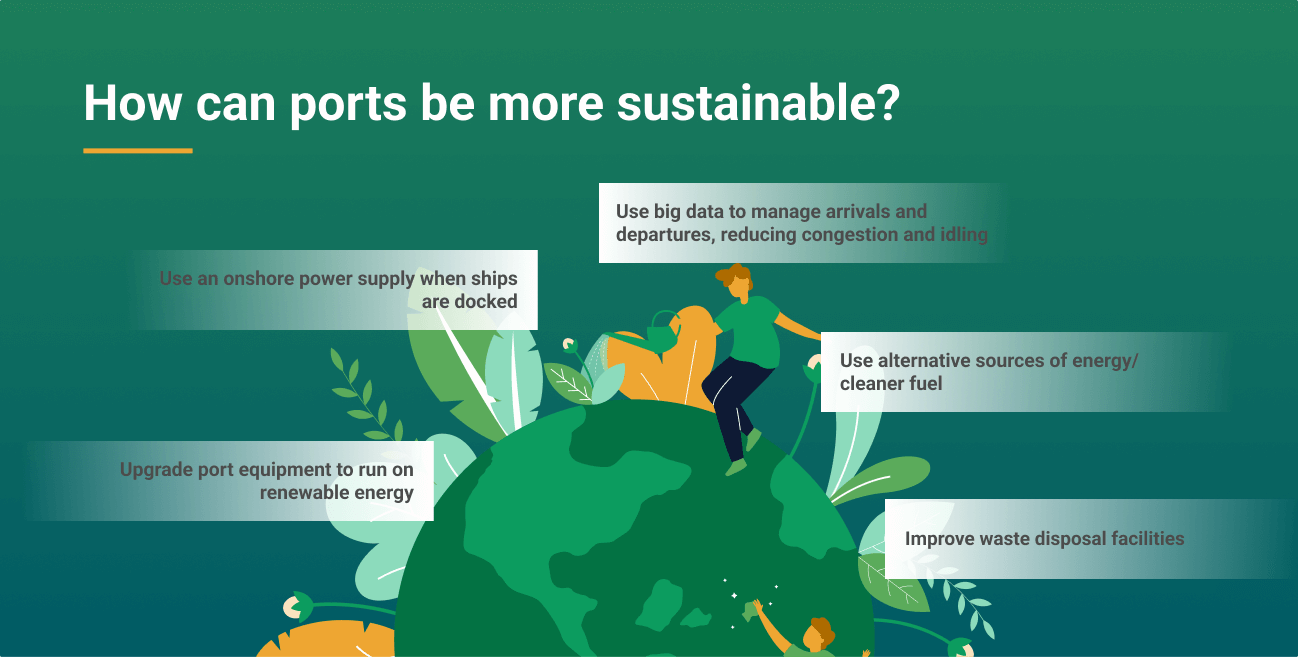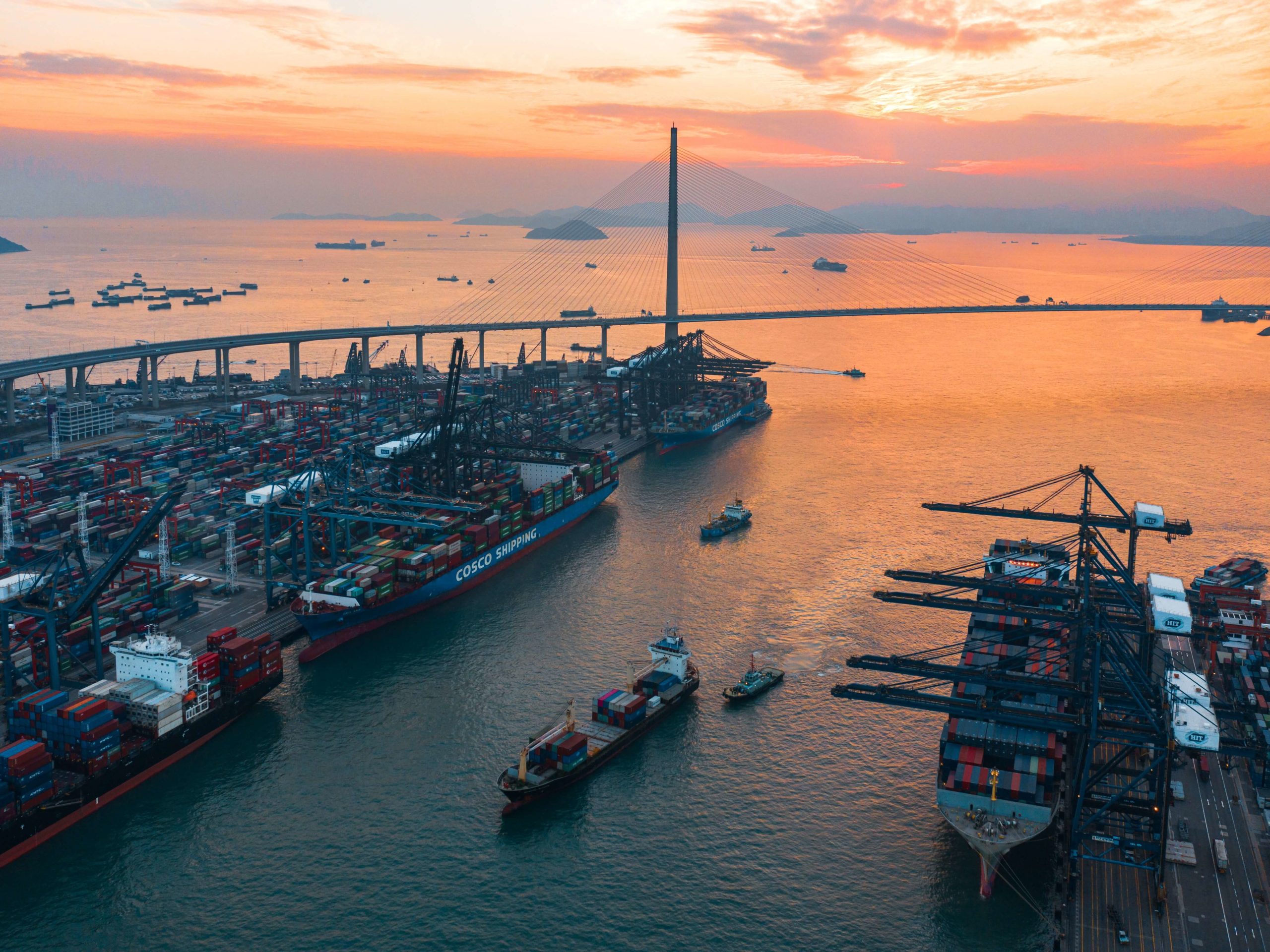As sustainability becomes more of a priority worldwide, various sectors are turning to alternative energy and cleaner fuel. The shipping industry, a major fossil fuel-consumer and contributor to greenhouse gasses, has begun its green journey by focusing on sustainable ports.
If you’re reading this, you probably want to know how ports can move towards a more sustainable future. Let’s dive into the current facts, to see what the shipping industry is doing at the moment, and for the future.
Interested in solving your empty container repositioning problem? Learn more about how xChange can help you. Sign up for a free demo of our easy-to-use platform by clicking below
Sustainable ports: Environmental impacts of shipping ports
Currently, the situation is pretty bad. In all sectors, not just in the shipping industry. As the human population continues to increase steadily, industries must keep up with consistently higher demands.
At present, the shipping industry accounts for almost 90% of international trade. We need more and more cargo vessels to ship goods around the world. This will see the use of more fossil fuels with each passing year.
Besides air pollution, the shipping industry creates noise and light pollution as well. Ship engines are loud and disruptive. Think about it: large cranes moving containers around constantly, and noisy trucks driving up and down with heavy loads. We bet you wouldn’t want to live nearby. Bright lights on ships and in ports are also extremely disturbing to both human and ocean life.
CO2 and other greenhouse gas emissions from shipping vessels are of particular concern. These gasses contribute considerably to rising global temperatures and climate change as a whole. Besides this, they are harmful to humans, wildlife and ecosystems on land and in our seas.
The shipping industry produces around 940 million tons of CO2 a year, which is about 2.5% of the world’s total CO2 emissions.
If greenhouse gasses continue to remain unregulated, emissions could rise by 50-250% by 2050, according to an IMO study.
Here’s a graph illustrating the current trajectory of CO2 emissions if left unchecked:

How do shipping ports affect the environment?
The shipping industry hasn’t changed much in the last 50 years. It still runs on the same fossil fuels it’s run on for over 100 years. And ports still use the same kinds of machinery for lifting and transporting containers.
Vessels and machinery using diesel and other fossil fuels produce carbon dioxide, nitrogen oxides, sulfur oxides and greenhouse gasses.
Ships empty waste-water into the oceans, including sewerage and bilge water. Bilge water is dirty water mixed with oil, which degrades ocean environments causing damage and loss of species.
Vessels also dump waste such as plastics and broken shipping equipment overboard. Around 20% of all marine litter comes from the shipping industry, and about 34% of all shipping garbage ends up in the sea.
This helps to contribute to large islands of trash forming in certain parts of the ocean. Have you heard of the Great Pacific Garbage Patch? Currently, this garbage patch covers an area twice the size of Texas, and three times the size of France. And it’s still growing.
Here are some more facts about the shipping industry:

It sounds like it’s all doom and gloom, but there’s actually a lot that can be done to change things. A more sustainable approach is possible, but it’s going to take some serious adapting. Every link in the supply chain industry will need a makeover, from machinery and fuel, to the technology and day-to-day practices of port workers.
Want to learn more about green shipping? Check out this report.
What are sustainable shipping ports?
Sustainable ports are the way of the future. They operate with environmental impacts in mind, and take steps to mitigate these wherever possible. Sustainable ports focus on the social, economic and environmental impacts, as well as business as usual.
Ports are the central nodes connecting ships worldwide. As hubs for the industry, any changes made can have a positive ripple affect on the rest of the sector. This is why the focus is now on creating sustainable ports, and branching out from there.
Regulations by the International Maritime Organization (IMO) and the European Green Deal (EGD) are a step in the right direction.
Some of the most recent policies put in place by the IMO include a focus on:
- Cleaner air: Making drastic cuts in sulfur oxide emissions from vessels.
- Human health: Putting regulations in place to improve air quality by reducing the emissions of harmful gasses.
- High quality fuels: Implementing the use of fuels that have low emission rates and are not harmful to the environment.
- Industry guidance: Releasing industry guidelines that are constantly monitored.
Want to find out more about the IMO regulations? Check out this separate blog post.
Improving the sustainability of ports
Here are some of the most important changes that can be made to ports reduce their environmental impact, as well as their carbon footprint:
Provide alternative energy sources for docked ships
The shipping industry produces some of the world’s dirtiest fuel. Luckily, the modification of port infrastructure to provide alternative fuels such as liquified natural gas instead of fossil fuels has already been mandated by the latest IMO regulations.
Ships docked at ports can also plug into the “electrical grid” (powered by renewable energy). This helps prevent the release of greenhouse gasses, as well as oil spills, and is known as onshore power supply (OPS).
Improve waste disposal facilities
Improper waste disposal is a major threat to our oceans. Ports can improve these systems without harming ocean life or the environment.
For example, ballast water and other ship waste can be pre-treated before being dumped into the sea. Although ultimately, we’d want a solution that didn’t involve any dumping at all, of course.
Rainwater can also be harvested and stored for cleaning purposes and other activities in ports.
Utilize big data to improve efficiency
Currently ports worldwide are congested, and ships spend ages idling while they wait to offload cargo. This leads to unnecessary fuel usage, as well as the risk of oil spills.
As a solution, ports can make use of big data and predictive tools to improve the scheduling of vessels, preventing pile ups. This would seriously enhance the productivity at ports, save time and money, and avoid fuel wastage and unnecessary emissions.
Upgrade port equipment
Currently, port equipment isn’t built with sustainability in mind. Machines like cranes, forklifts and trucks use diesel, adding to the already high carbon footprint of the industry. But it’s now possible to upgrade these machines to use cleaner fuels with lower emissions.
Reduce noise and light pollution
Ship engines produce underwater noise pollution, which can disturb ocean life. Light pollution does the exact same thing.
Ports can issue rules to limit the use of bright lights at night and restrict the time that ships are allowed idle at the port, in order to reduce the noise of engines.

Sustainable ports: Examples of improvement and innovation
Some ports around the world have already altered their technology, machinery and methods for the better. They’re leading by example.
Singapore, Taiwan, Hong Kong and Rotterdam Ports: Sustainability through automation
Singapore, Taiwan and Hong Kong are all in the process of automating their ports. This means computers in a control room manage all cranes and dangerous equipment. Staff no longer have to be inside the vehicles to operate them. This has led to increased efficiency in unloading cargo.
In the Port of Rotterdam (Netherlands), workers control cranes remotely, decreasing transport costs and improving human safety.
Sustainable and energy-efficient: San Diego Port (US)
The Port of San Diego was one of the first ports to focus on energy efficiency, way back in 2014. San Diego adopted the Climate Action Plan, and their efforts have reduced more than 56,000 metric tons of greenhouse gas emissions.
The Port of Krishnapatnam (India): A firm focus on sustainable practices
Krishnapatnam has always had a focus on environmentally sustainable growth. They conduct yearly tree plantation drives, and over 60% of the port operates on wind power. They also have structured water and sewage management systems that help control emissions and reduce pollution.
Sustainable port management: Port of Algeciras Bay (Spain)
The Port of Algeciras Bay is driving a program called Algeciras BrainPort 2020 (ABP 2020). They’re working towards a new port management model that will improve port efficiency, security and sustainability through digitization.
The most sustainable port in Germany: Hamburg Port
Hamburg shows us that environmental sustainability and economic success go hand-in-hand. Ship mooring spaces are equipped with land power connections, to reduce emissions while ships are docked. The port has also been using sulfur-free fuels for its fleets since 2009.

Challenges to creating sustainable ports
The solutions sound great, why not just implement them all today? Well, as always, there are many obstacles to implementing these changes.
You know how it goes – implementing something new in your business is risky, and can cost you money and even customers. The same goes for sustainable port development in the shipping industry.
Let’s take switching to low sulfur fuel as an example. While doing so would reduce harmful by-products from entering the environment, the cost, availability and specifications of new fuel for use in marine engines are still gray areas. The petroleum industry will need to adapt refineries and supply chains, and is likely to pass these costs on to the market.
Generally speaking, complying with IMO regulations is likely to lead to challenges such as freight rate increases and delays. This is because newer fuels and technologies need to go through various phases of testing before they’re given the all-clear.
Delays and price increases are to be expected as new fuels, methods and machinery are evaluated. This will in turn impact how the industry functions as a whole. So changes aren’t likely to happen overnight, and trial and error will be necessary.
Implementing sustainable technologies needs to be done in such a way that still brings about profit, and doesn’t completely cripple the shipping industry. Sustainable port development needs to be both good for the environment, and good for the industry’s longevity.
Sustainable ports: Solve your empty container repositioning problem with xChange
Empty container repositioning is expensive, not to mention wasteful. Currently, the shipping world transports every third container empty. That’s at least 60 million empty container moves every year. This problem is bad for business, not to mention the environment.
xChange is a transparent and neutral marketplace for buying, selling and leasing shipping containers. We connect container owners and users in over 2500 locations worldwide. All on one simple platform.
If you’re a container owner who repositions containers empty, we’ll connect you with hundreds of members wanting to lease your containers today. No more wasting time and money, now you’ll be making money instead.
Don’t believe it’s so easy? Why not try out our leasing public search to see for yourself? Just select “I want to supply containers!”, and type in your pick-up and drop-off locations to find partners right away.
Lease out your boxes easily on Container xChange
On xChange, you can decide on the rate for your boxes, and sign a deal only when you’re completely comfortable with the terms. Finally, an easy way to make money on all those empty containers giving you a headache!
Connect with partners, negotiate deals, sign contracts, and make payments, all in one place. Finally, you don’t have to worry about switching between platforms and signing in and out of different accounts.
If you’re looking for a more efficient, simple and sustainable solution for your container logistics, sign up for a free demo today. It’ll be great for the environment, and your pocket.
How can we make ports more sustainable?
We can make ports more sustainable in many ways. 1) Connect ships to the electrical grid when berthed to reduce air pollution. 2) Refuel ships with liquified natural gas to minimize greenhouse gas emissions. 3) Improve waste disposal systems. 4) Use big data to streamline arrival and departure times.
What does sustainable port development mean?
Sustainable port development involves changing how ports run so that machinery, operations and port activities are more environmentally-friendly.
How do ports negatively affect our environment?
Ports negatively affect our environment in a number of ways. The shipping industry produces large amounts of ocean waste water. This contributes to the degradation of marine habitats, and causes the loss of species. Ships also run on fossil fuel, and emit carbon dioxide and other greenhouse gasses into the environment.




